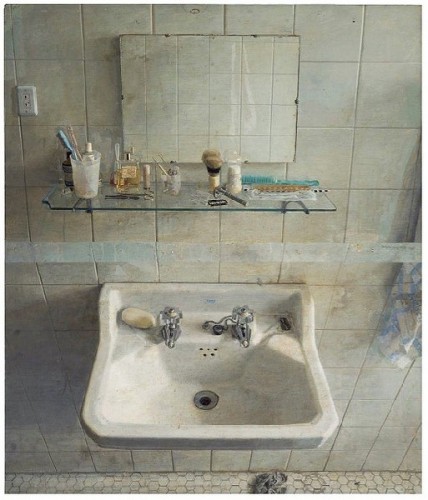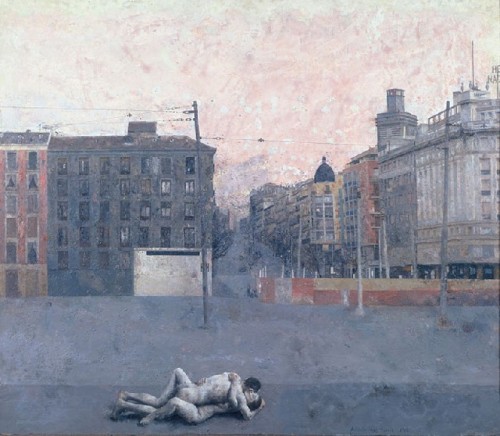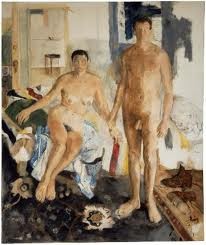Realist Collection for the Museum of Fine Arts
A Singular Vision: The Melvin Blake and Frank Purnell Legacy
By: Charles Giuliano - Sep 23, 2013
A Singular Vision: The Melvin Blake and Frank Purnell Legacy
Museum of Fine Arts, Boston
Catalogue: Essays by Cheryl Brutvan with an introduction by Malcolm Rogers, 88 Pages
February 4 to August 24, 2003
Posted to Maverick Arts Magazie, March 14, 2003
The acquisition of 60 drawings, paintings and sculptures including the first works to enter the collection by the surrealists, Rene Magritte, Balthus, and Paul Delvaux, as well as, a small, but choice, painting by Lucian Freud, six works by the Spanish realist, Antonio Lopez Garcia, and a dozen works by the Latin American realist, Claudio Bravo should be cause for celebration. But, well, not really.
There are some choice and desirable objects from the holdings of the late doctors, Melvin Blank and Frank Purnell, in particular, several riveting, early paintings from the best period of Larry Rivers, the American popish painter, who passed away last year. But most of the work in this selection ranges from enervating, to academic, to ludicrously pedestrian.
As this body of acquisitions enters the permanent collection of the MFA it is important to remember that the permanent collection is just that, permanent. Meaning that we will have to live with and contemplate this marginal cattle call of largely Spanish and Latin American paintings forever and ever. Eternity is, indeed, a rather long time.
The museum, under its British born director, Malcolm Rogers, is in the process of building a great addition designed by Lord Norman Foster. That will play out over the next decade. Let us hope that the contemporary department will include adequate storage facilities to stash away this ephemera. These reactionary, mostly figurative, anti-modernist acquisitions reflect the conservative, bourgeois taste of the director, Rogers, a notorious meddler, and his curator, Cheryl Brutvan. After a number of years in her position, she is yet to curate an inspiring, gutsy exhibition or make notable, risk taking acquisitions.
But, rather than fault Rogers and Brutvan, laying burden and blame on their shoulders, let us note that they are only sustaining the sad legacy of the Museum of Fine Arts over more than the past century. Of the handful of world class, American museums the MFA holds the least notable collection of modern and contemporary art. Even the nearby Rose Art Museum collection, started in 1963, by the founding director, Sam Hunter, is more remarkable.
The MFA did not officially establish a department and policy for contemporary art, until 1971, with the founding curator, Kenworth Moffett. He left a collection with great depth in Morris Louis, Color Field Paintings, a couple of major David Smith sculptures, and some now rather forgotten examples of realism. He was followed by one Amy Lighthill, who landed the position on a fluke, produced weak and eccentric exhibitions and quirky acquisitions. Lighthill, who, to her credit, championed local artists, was ultimately eased out and has since left the field. She was followed brilliantly, but briefly, by Kathy Halbrich as a transition from MIT to the Walker Art Center. Her assistant, Trevor Fairbrother, a scholar of John Singer Sargent, curiously evolved into the contemporary curator. His departure opened the way for Brutvan who has proved to be a less than stunning hire.
It was rumored, at the time, that several highly recruited curators were unwilling to come to a museum with no real contemporary collection and little real support from the community and the director. Boston is not noted for great contemporary collectors. That fact seems linked to a lack of interest and leadership at the MFA. Compounding the issue, up to now, the Institute of Contemporary Art has no permanent collection. So, why should collectors collect when there is no place to put their collections. It’s a classic conundrum. That could change. I may be terribly wrong and unfair, but nothing, so far, has disproved that impression.
Boston’s small, but dynamic, avant-garde art community has never recovered from such Rogers extravaganzas as full tilt boogie shows of Herb Ritts and Karsh photography, the cartoon series, Wallace and Gromit, or the Guitar show. The taste of Rogers, an interesting concept, favors populist flavors of low brow and kitsch.
There are blips on the radar screen, like last summer’s Broad Collection, which brought magnificent works to a hungry Boston audience. If only the MFA were announcing major acquisitions from that collection. It would, indeed, be a time for dancing in the street.
Instead, we find ourselves wallowing in Spanish and Latin American, academic, figurative painting, a touch of surrealism, and, oh yes, those wonderfully tasty works by Rivers.
On the plus side, the MFA now allows nudes. Way back when, the museum adopted its ultra conservative policy, when it acquired, Carmelina, an early nude by Matisse. The museum kept the painting but at least one trustee quit because the museum was no longer a safe haven for his wife and daughters. That more or less ended collecting challenging contemporary art for at least fifty years.
A former director, Alan Shestack, who preceded Rogers, attracted national media attention when he refused a collections committee recommendation to acquire a life size, full length, nude Polaroid of Beat Poet, Allen Ginsberg, by photographer, Elsa Dorfman. At the time, Shestack stated that the nude image was inappropriate for the diverse MFA audience.
So, at least that has changed. This selection of acquisitions just reeks of frontal nudity. It seems to have been a passion of the good doctors. Particularly young males with spectacular bodies. Like, “Portrait of Mr. Couchez,” (1978) a large nude of a black man cupping his genitals with both hands. His clothes are strewn at his feet. The painting, however brilliantly real and detailed, lacks balls on many levels. But, in conservative Boston we call this progress.
Perhaps, the most treasured works in this group of 60 acquisitions will be the several paintings, drawings, and painted reliefs by Antonio Lopez Garcia. His works are avidly sought but there is limited availability. He is said to paint very slowly and meticulously. The gem here is, Lavabo y espejo, (1967-68). It represents a downward perspective view of a bathroom sink, tiles, glass shelf with toiletries, and a small mirror. It is a miracle of trompe l’oeil.
The much-touted Magritte, Les Graces Naturelles, (1942) which depicts bird-leaves conflated, is little more than an autograph by the notable Belgian surrealist. The several works by the surrealist, Paul Delvaux, are more representative of the oeuvre of the artist but he is regarded in the second tier of that movement. Frankly, I have always enjoyed his dream sequence works and I look forward to viewing them in perpetuity. The Balthus drawings are strong and representative of the artist’s obsession with pubescent girls.
The range of works by the Spanish and Latino artists- Rafael Cidoncha, Xavier Corbero, Vincent Desiderios, Francisco Farreras, Domenico Gnolio, Julio Hernandez, Carmen Laffon, Guillermo Liedo, Javier Martin, and Lucio Munoz, does little to stimulate or sustain my interest. And those two nudes, Venus, by Fernando Botero, a drawing and a sculpture, are just hilarious. Talk about a bloated reputation. Remember when his puffy sculptures were installed on Park Avenue in NYC? Not a great moment in that great city’s cultural heritage.
We have saved the best for last. All of this I am willing to endure for the sublime opportunity to enjoy several great, early nudes by Larry Rivers. He was rarely better than his, Bedroom, 1955. It represents a woman seated on a bed and beside her a standing male. Brutvan’s sadly limited essay offers no hint, clue, or footnote to their identity. In general, her poorly documented catalog is little more than a picture book.
One should not look a gift horse in the mouth. The MFA, considering its pathetic legacy of Modernism should be grateful for whatever it can attract. For free. But, clearly, no major collection is headed our way. Particularly, given our current director and curatorial vision, or lack thereof. In that sense, I mourn the past, indeed a sad history, and fear for the future.







